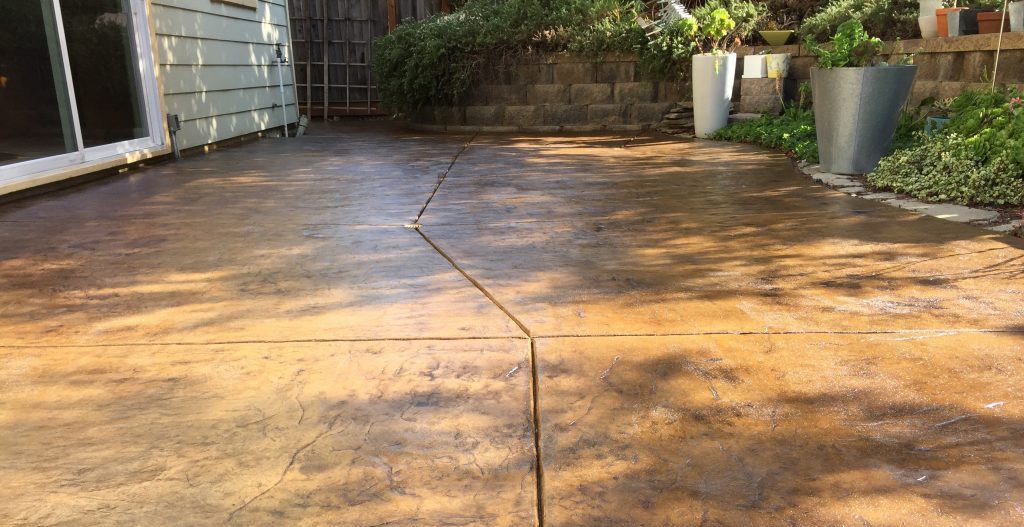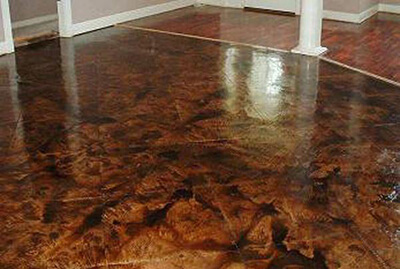Recognizing the Different Kinds of Stained Concrete for Your Following Task
Stained concrete deals numerous choices that cater to various visual and practical needs. Each kind provides distinctive characteristics that affect the final look and sturdiness of the surface area. Recognizing these distinctions is crucial for any individual planning a task. From abundant, chain reactions of acid-based stains to the dynamic harmony of solid shade stains, the options can considerably affect the result. What elements should one consider when picking the suitable discolor for their details demands?
Summary of Stained Concrete
Stained concrete functions as a flexible floor covering choice that can improve the visual charm of numerous rooms. This method entails applying a tinting agent to the surface of existing concrete, allowing for a broad spectrum of design possibilities. Stained concrete is preferred in both property and industrial settings, offering a sturdy and low-maintenance solution that can simulate the look of natural materials like rock or floor tile.
The discoloration procedure can be implemented using water-based or solvent-based items, each providing unique aesthetic effects. The final appearance is influenced by aspects such as the initial concrete surface, the sort of tarnish utilized, and the application technique. Stained concrete not just beautifies interiors and outsides yet also promotes sustainability by renewing existing concrete structures. As a result, it has obtained grip among house owners and developers seeking both performance and style in their floor covering selections.
Acid-Based Stains: Qualities and Benefits

One-of-a-kind Color Variants
Concrete surfaces can transform dramatically with the application of acid-based stains, which provide an abundant scheme of special shade variants. These stains permeate the concrete, responding chemically to create vivid planet tones that range from deep browns and reds to soft eco-friendlies and blues. The resulting shades are usually variegated, creating a natural, marble-like appearance that improves the concrete's personality. Each application yields unique outcomes because of variations in the concrete's composition and the staining technique used, making every job special. In addition, acid-based stains can be split or incorporated with other techniques to produce customized designs, enabling individual expression. This flexibility makes acid-based stains a preferred selection for both household and business applications.
Chain Reaction Explained
While numerous variables add to the effectiveness of acid-based stains, the underlying chain reaction play a necessary function in their special features and advantages. These stains mostly are composed of water, acid, and metal salts. When related to concrete, the acid reacts with the calcium hydroxide in the cement, developing a chemical improvement that results in irreversible color changes. The metal salts penetrate the surface and bond with the concrete, permitting for a vast array of colors and tones. This reaction not just boosts aesthetic allure yet likewise provides sturdiness, making the color immune to fading and wear. Furthermore, acid-based stains can create a variegated coating that simulates natural rock, additional enhancing their appeal for ornamental concrete applications.
Surface Area Preparation Value
Attaining optimal results with acid-based stains hinges on extensive surface area preparation. This essential action guarantees that the concrete surface area is tidy, without pollutants, and effectively profiled for perfect stain absorption. Any type of existing sealants, dirt, or oils can hinder the chain reaction that creates the desired shade and finish, leading to uneven or patchy results.
Prior to using the stain, the concrete should be mechanically cleaned up or pressure cleaned, followed by a comprehensive assessment for cracks or imperfections that may need fixing. Additionally, verifying the surface area is appropriately dried out will certainly boost tarnish adherence. By prioritizing these primary measures, the long life and vibrancy of acid-based stains can be considerably enhanced, resulting in an extra aesthetically pleasing and durable finish.
Water-Based Stains: Functions and Advantages

Water-based stains penetrate the concrete, offering an extra translucent finish that highlights the all-natural texture and variants of the surface beneath. They are readily available in a vast variety of shades, allowing for imaginative flexibility in design. Furthermore, water-based stains are easier to clean up, needing just water and soap, which simplifies the application procedure.
Their fast drying out time improves performance, making them a functional selection for both do it yourself lovers and experts. On the whole, water-based stains supply an appealing mix of visual adaptability and straightforward properties, making them a popular option for concrete improvement projects.
Solid Shade Stains: Lively Alternatives for a Bold Appearance
Solid shade stains provide an effective solution for those seeking to create a vibrant and vivid visual on concrete surface areas. These stains give a consistent pigmentation that can significantly boost the visual allure of floors, patio areas, and driveways. Offered in a vast range of colors, solid color stains enable innovative expression, dealing with various design choices.
Among the crucial advantages of solid shade stains is their capability to conceal blemishes, giving a fresh and refined seek to aging concrete - local stained concrete. Additionally, their solution generally includes UV-resistant homes, making certain longevity and shade retention also in severe climate condition
Application is simple, requiring marginal prep work of the concrete surface. As soon as applied, strong color stains can be secured for included security and sheen, more raising their aesthetic top quality. With their dynamic alternatives, solid shade stains are a superb option for those going for an impactful and natural design.
Semi-Transparent Stains: Attaining Depth and Measurement
Semi-transparent stains offer a special method to boosting concrete surface areas by supplying deepness and measurement with various color alternatives. Comprehending the application strategies is necessary for achieving the wanted effect, while proper maintenance methods ensure long life. This area will check out these vital elements to take full advantage of the advantages of semi-transparent staining.
Color Options Available
A vast range of shade alternatives exists for semi-transparent stains, allowing house owners and designers to enhance the all-natural beauty of concrete surface areas. These stains come in a range of colors, from natural tones like browns and try here terracottas to vibrant colors read what he said such as blues and environment-friendlies. The semi-transparent nature of these stains allows the underlying concrete to show via, developing a distinct depth and dimension that can match numerous style aesthetics. In addition, integrating various colors can create personalized tones, making it possible for a customized appearance for each project. This flexibility makes semi-transparent stains a prominent option for both interior and exterior applications, as they can balance with surrounding aspects while adding visual interest to plain concrete.
Application Methods Clarified
To achieve the wanted deepness and measurement with semi-transparent stains, correct application strategies are important. Surface preparation is vital; the concrete needs to be clean and totally free of any contaminants. This often entails power cleaning and repairing any fractures. Next, picking the ideal applicator, such as a sprayer, roller, or brush, can influence the last look. Sprayers permit an extra also application, while rollers can help accomplish appearance. It is necessary to apply the stain in thin, also layers, enabling each layer to completely dry before adding another. Adjusting the application method, such as varying stress or using various tools, can produce distinct effects. Securing the stained surface boosts the vibrancy of the colors while giving security.
Upkeep Best Practices
Normal maintenance is essential for protecting the beauty and stability of surface areas treated with semi-transparent stains. To maintain these surfaces, routine cleansing is vital. Utilizing a pH-neutral cleaner and a soft-bristle mop will certainly help eliminate dust and debris without damaging the discolor. It is suggested to stay clear of severe chemicals, as they can deteriorate the discolor's look. In addition, regular resealing every one to three years can shield versus wear and fading. This process includes cleaning up the surface area thoroughly and applying a suitable sealer made for stained concrete. Property owners must additionally monitor for any indications of staining or damage and address these concerns quickly to guarantee long-lasting vibrancy and durability. Adhering to these ideal techniques will enhance the overall lifespan of semi-transparent stained surfaces.
Impacts and Methods: Personalizing Your Stained Concrete
Personalizing stained concrete includes a variety of methods that improve both aesthetics and performance. Amongst these approaches, layering various discolor colors can create depth and intricacy, permitting for one-of-a-kind aesthetic results. Strategies such as acid discoloration supply a variegated appearance, while water-based stains provide a more uniform appearance.
In addition, including decorative patterns, such as stenciling or inscription, can additionally individualize the surface, including intricate styles that satisfy specific tastes. Texturing the concrete, whether through marking or mop surfaces, introduces responsive aspects that not only boost grasp yet likewise enhance aesthetic rate of interest.
Additionally, applying sealants can magnify the shade vibrancy and give security against wear. Personalization techniques expand beyond plain color; they can change a typical concrete slab right into a spectacular prime focus, making it appropriate for both residential and business spaces. Via careful option of impacts and techniques, stained concrete can accomplish an absolutely customized look.
Maintenance and Long Life of Stained Surfaces
Although stained concrete surfaces are known for their sturdiness and aesthetic charm, keeping their stability is important for guaranteeing long life. Routine cleaning is crucial; sweeping and mopping with a pH-neutral cleaner assists protect against dust buildup and discoloration. Additionally, applying a sealer every couple of years can shield the surface from wetness, chemicals, and UV damages, therefore improving its life expectancy.
It is additionally important to deal with any type of splits or chips promptly. Little repair services can mitigate further degeneration, maintaining the aesthetic and architectural top my review here quality of the surface area. For outdoor stained concrete, seasonal maintenance, such as eliminating snow and ice, is needed to stop surface area damages from freeze-thaw cycles.
Regularly Asked Inquiries
Can I Tarnish Existing Concrete Surfaces or Just Brand-new Ones?
The inquiry of whether existing concrete surfaces can be stained occurs regularly. It is certainly feasible to discolor both new and old concrete, provided the surface area is effectively prepared and devoid of impurities for ideal adhesion.
For how long Does the Staining Refine Usually Take?
The staining procedure generally takes one to 3 days, relying on elements such as surface area preparation, sort of discolor, and weather. stained concrete contractors. Treating time might extend past preliminary application, affecting the overall period considerably
Is Stained Concrete Safe for Outdoor Usage?
Stained concrete is generally risk-free for exterior usage, offered it is effectively sealed. This sealing shields against wetness and UV damages, making sure toughness and safety, while additionally boosting the aesthetic charm of exterior spaces.
Can I Apply Numerous Discoloration Layers for Different Impacts?
Using numerous stain layers can accomplish diverse results on stained concrete. However, it is crucial to guarantee compatibility between stains and allow appropriate drying out time between applications to avoid unexpected reactions or discoloration.
Are There Any Type Of Color Limitations for Stained Concrete?
Color restrictions for stained concrete mostly rely on the kind of stain utilized, with water-based stains providing a more comprehensive scheme contrasted to acid-based stains. stained concrete floors. Nevertheless, accomplishing dynamic shades may need cautious choice and application methods